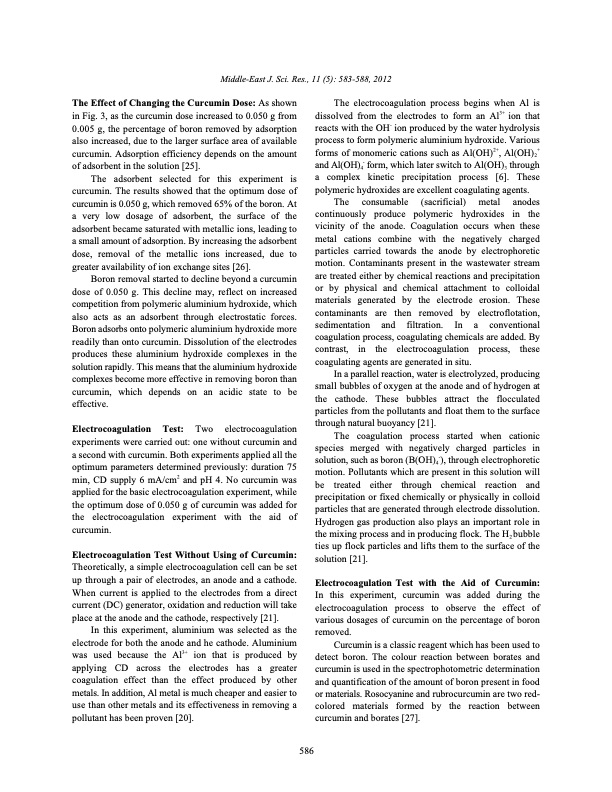
PDF Publication Title:
Text from PDF Page: 004
The Effect of Changing the Curcumin Dose: As shown in Fig. 3, as the curcumin dose increased to 0.050 g from 0.005 g, the percentage of boron removed by adsorption also increased, due to the larger surface area of available curcumin. Adsorption efficiency depends on the amount of adsorbent in the solution [25]. The adsorbent selected for this experiment is curcumin. The results showed that the optimum dose of curcumin is 0.050 g, which removed 65% of the boron. At a very low dosage of adsorbent, the surface of the adsorbent became saturated with metallic ions, leading to a small amount of adsorption. By increasing the adsorbent dose, removal of the metallic ions increased, due to greater availability of ion exchange sites [26]. Boron removal started to decline beyond a curcumin dose of 0.050 g. This decline may, reflect on increased competition from polymeric aluminium hydroxide, which also acts as an adsorbent through electrostatic forces. Boron adsorbs onto polymeric aluminium hydroxide more readily than onto curcumin. Dissolution of the electrodes produces these aluminium hydroxide complexes in the solution rapidly. This means that the aluminium hydroxide complexes become more effective in removing boron than curcumin, which depends on an acidic state to be effective. Electrocoagulation Test: Two electrocoagulation experiments were carried out: one without curcumin and a second with curcumin. Both experiments applied all the optimum parameters determined previously: duration 75 min, CD supply 6 mA/cm2 and pH 4. No curcumin was applied for the basic electrocoagulation experiment, while the optimum dose of 0.050 g of curcumin was added for the electrocoagulation experiment with the aid of curcumin. Electrocoagulation Test Without Using of Curcumin: Theoretically, a simple electrocoagulation cell can be set up through a pair of electrodes, an anode and a cathode. When current is applied to the electrodes from a direct current (DC) generator, oxidation and reduction will take place at the anode and the cathode, respectively [21]. In this experiment, aluminium was selected as the electrode for both the anode and he cathode. Aluminium was used because the Al3+ ion that is produced by applying CD across the electrodes has a greater coagulation effect than the effect produced by other metals. In addition, Al metal is much cheaper and easier to use than other metals and its effectiveness in removing a pollutant has been proven [20]. The electrocoagulation process begins when Al is dissolved from the electrodes to form an Al3+ ion that reacts with the OH- ion produced by the water hydrolysis process to form polymeric aluminium hydroxide. Various forms of monomeric cations such as Al(OH)2+, Al(OH)2+ and Al(OH)4- form, which later switch to Al(OH)3 through a complex kinetic precipitation process [6]. These polymeric hydroxides are excellent coagulating agents. The consumable (sacrificial) metal anodes continuously produce polymeric hydroxides in the vicinity of the anode. Coagulation occurs when these metal cations combine with the negatively charged particles carried towards the anode by electrophoretic motion. Contaminants present in the wastewater stream are treated either by chemical reactions and precipitation or by physical and chemical attachment to colloidal materials generated by the electrode erosion. These contaminants are then removed by electroflotation, sedimentation and filtration. In a conventional coagulation process, coagulating chemicals are added. By contrast, in the electrocoagulation process, these coagulating agents are generated in situ. In a parallel reaction, water is electrolyzed, producing small bubbles of oxygen at the anode and of hydrogen at the cathode. These bubbles attract the flocculated particles from the pollutants and float them to the surface through natural buoyancy [21]. The coagulation process started when cationic species merged with negatively charged particles in solution, such as boron (B(OH)4-), through electrophoretic motion. Pollutants which are present in this solution will be treated either through chemical reaction and precipitation or fixed chemically or physically in colloid particles that are generated through electrode dissolution. Hydrogen gas production also plays an important role in the mixing process and in producing flock. The H2 bubble ties up flock particles and lifts them to the surface of the solution [21]. Electrocoagulation Test with the Aid of Curcumin: In this experiment, curcumin was added during the electrocoagulation process to observe the effect of various dosages of curcumin on the percentage of boron removed. Curcumin is a classic reagent which has been used to detect boron. The colour reaction between borates and curcumin is used in the spectrophotometric determination and quantification of the amount of boron present in food or materials. Rosocyanine and rubrocurcumin are two red- colored materials formed by the reaction between curcumin and borates [27]. Middle-East J. Sci. Res., 11 (5): 583-588, 2012 586PDF Image | Boron Removal from Aqueous Solutions

PDF Search Title:
Boron Removal from Aqueous SolutionsOriginal File Name Searched:
boron-curcumin.pdfDIY PDF Search: Google It | Yahoo | Bing
CO2 Organic Rankine Cycle Experimenter Platform The supercritical CO2 phase change system is both a heat pump and organic rankine cycle which can be used for those purposes and as a supercritical extractor for advanced subcritical and supercritical extraction technology. Uses include producing nanoparticles, precious metal CO2 extraction, lithium battery recycling, and other applications... More Info
Heat Pumps CO2 ORC Heat Pump System Platform More Info
| CONTACT TEL: 608-238-6001 Email: greg@infinityturbine.com | RSS | AMP |